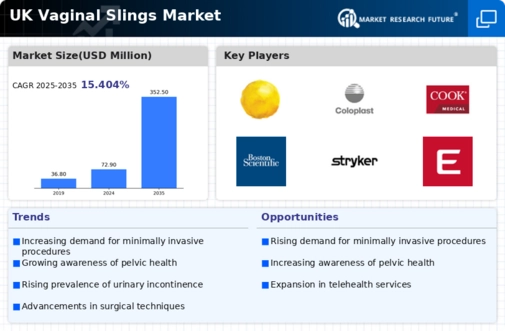Rising Geriatric Population
The ageing population in the UK is a significant driver for the vaginal slings market. As life expectancy increases, a larger segment of the population is entering the age bracket where pelvic floor disorders are more prevalent. Statistics indicate that by 2030, the number of individuals aged 65 and over will rise substantially, leading to a corresponding increase in health issues related to ageing, including incontinence. This demographic shift is likely to create a higher demand for effective treatment options, including vaginal slings. The vaginal slings market is thus poised for growth, as healthcare systems adapt to meet the needs of an ageing population.
Supportive Healthcare Policies
Supportive healthcare policies in the UK are fostering a conducive environment for the vaginal slings market. The National Health Service (NHS) has been increasingly prioritizing women's health, leading to improved access to treatments for pelvic floor disorders. Funding for surgical interventions and the promotion of evidence-based practices are encouraging healthcare providers to offer vaginal slings as a viable option. Additionally, initiatives aimed at reducing waiting times for surgical procedures are likely to enhance patient access to these treatments. As healthcare policies continue to evolve in favor of women's health, the vaginal slings market stands to benefit from increased patient uptake and support.
Growing Awareness and Education
There is a notable increase in awareness and education surrounding pelvic health issues in the UK, which is positively impacting the vaginal slings market. Campaigns aimed at destigmatizing pelvic floor disorders have led to more women discussing their symptoms and seeking treatment. Healthcare professionals are also becoming more proactive in educating patients about available options, including vaginal slings. This heightened awareness is reflected in a growing number of consultations and procedures performed. As women become more informed about their health, the demand for effective surgical solutions is expected to rise. Consequently, the vaginal slings market is likely to see sustained growth as awareness continues to expand.
Advancements in Surgical Techniques
Innovations in surgical techniques and materials are significantly influencing the vaginal slings market. Minimally invasive procedures, such as laparoscopic and robotic-assisted surgeries, have gained traction, offering patients reduced recovery times and lower complication rates. The introduction of new sling materials that enhance biocompatibility and reduce the risk of erosion has also contributed to the market's growth. For instance, the use of polypropylene mesh has become prevalent due to its strength and durability. As these advancements continue to evolve, they are likely to attract more patients seeking effective solutions for pelvic floor disorders. The vaginal slings market is thus experiencing a transformation, driven by these technological improvements.
Increasing Prevalence of Pelvic Floor Disorders
The rising incidence of pelvic floor disorders among women in the UK is a primary driver for the vaginal slings market. Conditions such as stress urinary incontinence and pelvic organ prolapse are becoming more common, particularly among older women. According to recent health statistics, approximately 30% of women over 50 experience some form of pelvic floor disorder. This growing prevalence necessitates effective treatment options, leading to an increased demand for vaginal slings. As awareness of these conditions improves, more women are seeking medical advice and treatment, further propelling the market. The vaginal slings market is thus positioned to benefit from this trend, as healthcare providers increasingly recommend surgical interventions to address these disorders.




















Leave a Comment